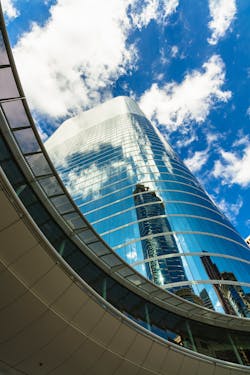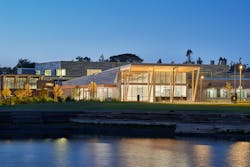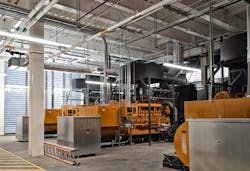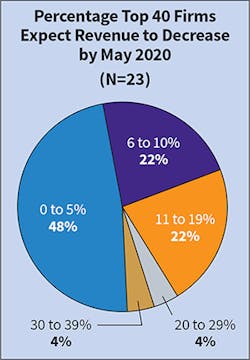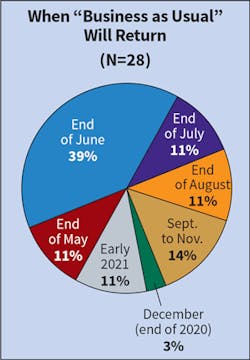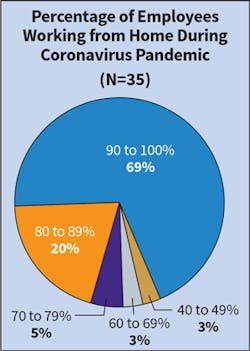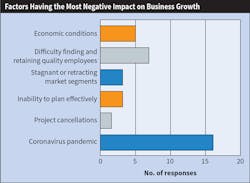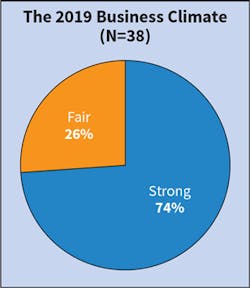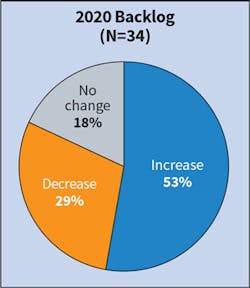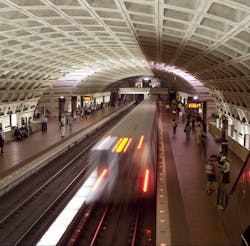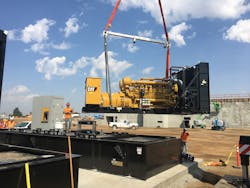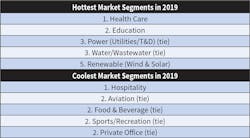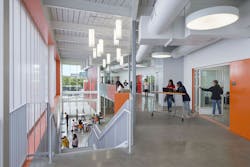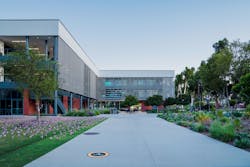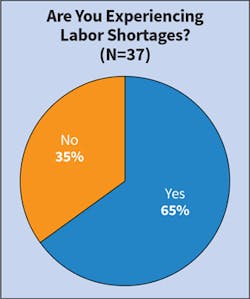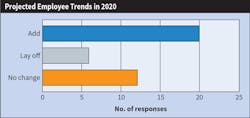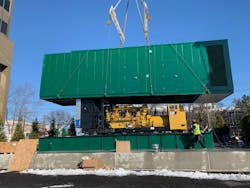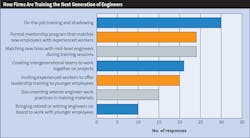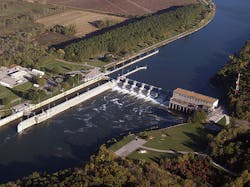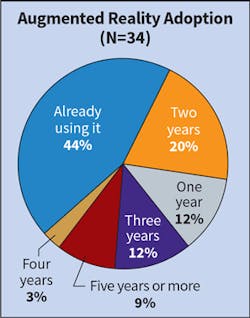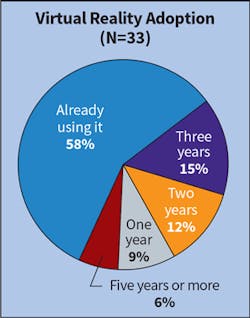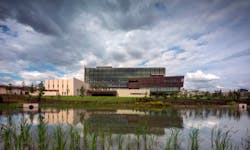Design Firms Face Uncertain Times: EC&M’s 2020 Top 40 Electrical Design Firms Special Report
To say that COVID-19 has cast a dark cloud over almost everything in 2020 would be an understatement — well after the virus passes, disfiguring scar tissue will still remain. Decades from now, the pandemic may be seen as a watershed moment in history, leaving the calendar with a new BC and AD: “before coronavirus” and “after destruction.”
It has whiplashed an economy that had been forging ahead for a decade to the brink of recession. Growth for many sectors of the economy is almost certainly off the table for the balance of 2020, and shocks to the system could mean full recovery is a couple of years off.
One industry almost certain to take a quick punch is building and construction, where many projects underway have been halted and others in the pipeline have been canceled or postponed. Looking farther down the road, questions loom about what infrastructure demand might look like amidst a crippled economy and possible “new normal” for how people interact and conduct business.
Engineering and design firms are on the front lines of the battle to find a way through to the other side of the pandemic-shaken construction economy, and there’s growing evidence that the industry is spooked. Many companies on this year’s 2020 Top 40 Electrical Design Firms roster indicate the pandemic, coming on the heels of another solid but down year for revenues, has jolted their business, leaving them uncertain and less optimistic about the balance of 2020 and maybe beyond.
In the April survey, just over half the firms said they expected their revenues to have fallen by the end of May, most expecting single-digit declines (Fig. 1). Most say business has been disrupted; predictions for a return to “business as usual” ranged from quickly to early 2021 (Fig. 2). One big part of that will be getting design teams back into offices, which have largely been abandoned. Two-dozen companies reported that all or most of their employees were working from home during the crisis (Fig. 3). In fact, the majority of respondents said their firms’ growth was now most imperiled by the pandemic (Fig. 4).
Rising worries
Having reported combined electrical design revenues of $2.195 billion for 2019, 6% less than revenues reported by last year’s Top 40 and the first decline in years, top firms are likely to absorb another collective revenue hit in 2020. Many of the three-quarters of companies that rated the 2019 business climate strong (Fig. 5), and of the 60% that said revenues topped expectations (Fig. 6), see a challenging second half on the horizon. Of the 35 respondents offering predictions, 17 firms (or 37%) expected full-year revenues to show a decline, up from the 21% of last year’s top firms who foresaw a 2019 decline (Fig. 7). Also, only 53% said they expected backlog to increase in 2020 (Fig. 8), following a year in which 83% said it had increased (Fig. 9). That’s a big drop from Top 40 surveys dating back three years, over which coming-year backlog growth predictions ranged from 76% to 95%. However, the magnitude of predicted change in either direction was mostly seen staying in single digits, mirroring the change range reported for 2019.
After seeing some newly awarded projects placed on indefinite hold, Jaros Baum & Bolles (JB&B) (No. 20), New York, is staring at a changed landscape. Earlier predictions of a healthy revenue increase, following a record-setting 2019, have given way to resignation that they will be down.
“The pandemic changed all that,” says Mark Torre, managing partner of the company, strong in health care, life sciences, and commercial sectors. “Based on current projections, we believe our revenue will be down significantly this year.”
Affiliated Engineers, Inc. (No. 14), Madison, Wis., has seen minimal disruption, says Principal Krista Murphy, but revenues are likely to fall for the year as some key markets, such as health care, possibly face cash crunches and go wobbly on commitments. Firmer campus electrical generation, laboratory, and utility system hardening projects could counter that, she says, but the big picture is now hazier.
“We’ve had such a strong run with the economy that we thought 2021 might mark the disruption point,” she says. “But that point in the future is now.”
Coming off another year of electrical design revenue growth (hidden in the official tally of Top 40 revenues due to changes in Burns & McDonnell’s internal revenue accounting) Burns & McDonnell (No. 1), Kansas City, Mo., is revisiting its 2020 projections. Despite seeing bid awards hold up into early May, Ray Kowalik, president and CEO, is convinced a recession-induced general construction downturn is in the offing. Challenges will become more acute and prolonged in some markets of historic company strength — notably, some aviation projects and oil and gas. Other anchors could hold up, and new toeholds could emerge. The net result, though, will likely be a revenue hit.
“Construction will be down 20% and could take two to five years to rebound,” he says. “It will be tougher times for the next two or three years. The likelihood of electrical projects growing in the next year or two is low because that’s too tied to GDP. If that’s not moving, electrical infrastructure won’t either.”
Bold government efforts to help the economy get through the pandemic without long-term damage could provide some relief. In fact, nearly 60% of respondents indicated that Congress’ recent $3-trillion stimulus program could have some positive impact on their businesses this year (Fig. 10).
A backlog that grew around 15% in 2019, and which remains largely on schedule, has Arora Engineers, Inc. (No. 33), Chadds Ford, Pa., looking past pockets of weakness. While some of its projects have been interrupted, others well along and widely shielded from work stoppage orders have continued, leading President and CEO Manik Arora to forecast a 6% to 10% revenue gain for 2020.
“We saw 60% growth in aviation design work last year, and that continues into 2020. To our surprise, it doesn’t seem to be impacted by the pandemic,” he says. “Some big projects that have had money appropriated and funded, like the JFK terminal in New York, are still going ahead. And some specialty projects, like airfield lighting, have actually accelerated with fewer planes flying.”
After a 14% revenue gain last year, Henderson Engineers, Inc. (No. 6), Lenexa, Kan., is penciling in an 8% revenue decline, based on the volume of work put on hold and understanding that a block of work in the hospitality, food and beverage, and office sectors is suddenly vulnerable.
“In retail, we’ve had clients hit hard by this, and restaurants are struggling,” says Dustin Schafer, engineering director/SVP says. “But we’re looking at how we can use engineering and design technologies to contribute to getting these businesses back up and running.”
Shifting markets
The pandemic, spawning immediate economic damage and possibly permanent shifts in how the economy functions, could ultimately alter demand and priorities in building and construction. Markets that have been reliably strong for electrical systems designers could recede while others on the periphery could surge. The very nature of projects within sectors could change, directly impacting the scope and content of electrical designers’ contributions.
Pre-pandemic, health care and education/institution had been reliably strong revenue-drivers for Top 40 companies asked to name their three “hottest” markets. They ranked No. 1 and No. 2 again last year, just as they did in 2016 and 2018; 2017 was an outlier, with more listing power, water, and transportation. Over several years, just a half-dozen markets have dominated the hottest list. But a fresh face in the top five this year is renewables. The top five “coolest” markets rankings have been less consistent. Hospitality got the most mentions this year, while retail led the way last year, and hospitality topped the 2017 list (Table 1).
Designers now seem to be sensing a possible slow-moving shift in market sector opportunity and demand. Many might be pulled into markets turbocharged by the pandemic, perhaps health care, life sciences/laboratories, and data centers. Others may gravitate away from those compromised by the double whammy of a recession economy and the virus, such as office, commercial, and hospitality.
Mesa Associates, Inc. (No. 5), Madison, Ala., will be watching for changes that could affect two of its core sectors. Work in one, industrial process design, has slowed, says Tim Cutshaw, executive vice president, while the transmission and distribution market could be vulnerable. Mesa has ridden a wave of distributed generation projects and sees another one building in renewables and energy storage. A recession that reduces energy demand could force customers to revisit their infrastructure and operational expenditures.
“We continue to get more RFPs, but utilities could be looking at loads decreasing — and that could possibly slow down work in the maintenance area, maybe more so than in capital projects,” he says.
Burns & McDonnell sees emerging opportunity in the data center market. It saw work expanding before the pandemic, but sees it accelerating as digital connectivity becomes more central to the economy. Kowalik says the company’s data center engineering business doubled last year and expects it to command more resources.
“There’s been a big surge in data usage, and these telecom infrastructure broadband projects are accelerating,” he says. “We’ll have to reallocate some design resources from slower markets like oil and gas into these types of projects.”
Meanwhile, the company’s utility client design work surged in 2019, benefitting from growing investments in areas like system hardening, renewable interconnects, electric vehicle charging infrastructure, and substation expansions. In program management work, it won a long-term contract to help Georgia Power enhance service and reliability, starting with T&D infrastructure upgrades.
Triad Consulting Engineers, Inc., (No. 15), Morris Plains, N.J., will be hobbled by a likely falloff in projects in the hospitality market, which accounts for 15% of its revenues, says CEO Ron Regan. Design work for some large Caribbean resorts might not resume for 18 months. But other big projects continue, like a massive battery plant under construction for a Korean client that’s still generating revenue, and could fill the gap.
“Manufacturing could be big as more of it moves back to the U.S. We do a lot of work in pharmaceutical, which could be incredibly strong in 2021,” he says.
Other firms anticipate little change in their client and project makeup. P2S, Inc. (No. 22), Long Beach, Calif., has seen some temporary pullbacks but few signs that the core business is at risk.
“We see that the same project types that had the most potential before the pandemic still hold — public and private laboratories and a range of project types in education and health care,” says CEO Kevin Peterson. “And infrastructure projects like a distribution and storage project at UC San Diego are going strong.”
Companies that specialize in markets that could be insulated from recession might be in a good place. Working primarily on federal government military, diplomatic, and security-related projects, The Mason & Hanger Group, Inc.
(No. 31), Lexington, Ky., has seen a few signs of a slowdown but expects ample revenue this year.
“We’ve evolved to become a one-stop shop for designing secure compounds, structures, and facilities for the government, and that’s protected us in the past from some from market dips,” says President Ben Lilly.
Electrical is an increasingly central design element in many projects given growing security needs and government mandates on energy efficiency. The company rates on-site, back-up power systems as the top area of emerging opportunity in building design, a choice shared by one-quarter of Top 40 firms. That and energy storage systems got the most mentions in a survey question on new revenue-generators in the commercial building sector.
Hiring effects
Lilly says designing electrical systems for routinely complex, mission-critical government projects takes a “special type” of engineer that can be hard to find. That amounts to a hiring challenge that has dogged the Top 40 firms during the long economic expansion. But the survey points to those challenges possibly moderating, and that’s probably pandemic-related. Sixty-five percent say they’re experiencing labor shortages, down from 75% the last two years (Fig. 11). Twenty firms say they’ll add employees in the current year, down from 34 the last two years (Fig. 12). As in previous years, however, most continued hiring in 2019, with 75% saying they added employees, in line with the last two years (Fig. 13).
Arora plans to add staff this year and expects a tougher business climate to make top talent more available.
Struggling to find affordable electrical talent in the five- to 15-year experience range, it acquired a firm in 2018 just to give it a “deeper electrical bench,” says the CEO.
“We could see the talent market open up and offer some candidates we’d never expect to see,” he says. “It was ‘name your price’ for engineers in 2019, but that won’t happen now.”
Triad looks to add staff this year barring a big downturn in business, which Regan says doesn’t appear likely. The company likes to fill its ranks from the intern pool, and two due to graduate were in line to receive offers. Regan says finding designers who are a good fit is an ongoing challenge and key to company success.
“Compensation has been the big issue in hiring, but we think it will increasingly be more lifestyle, and we think we’ll have some success luring workers to our
location outside New York City,” Regan says.
That aligns some with a survey finding that “a positive company culture” is the biggest key to retaining employees. That factor changed places with “competitive wages and compensation,” which was cited by more firms last year. Last year, 12 firms cited company culture; this year 19 did (Fig. 14).
PBS Engineers, Inc. (No. 37), Glendora, Calif., has addressed a labor pinch driving up compensation costs by investing more heavily in those with less experience. The company has developed more structured training, mentoring, and leadership development, offering an alternative to jumping into costly bidding wars for top talent.
“Rather than hiring the 10-year experience designer, we’re hiring more straight from college and molding them to our way,” says Kunal Shah, company president. “They’ve gotten more opportunities for growth and become more invested in the company. In the last few years, our turnover has been less as well.”
Hiring less experienced engineers might be the route more firms take, especially if the recession proves short-lived and employment bounces back quickly. The position of staff engineer, often filled by new graduates, was again ranked one of the easier positions to fill. The hardest to fill continue to be managing roles such as project and supervising engineer (Fig. 15).
Training importance
Many top firms seem to be copying elements of PBS’s approach. The leading strategies companies are using to train young engineers are on-the-job training, formalized mentoring, and bringing new hires close together with mid-level engineers in training sessions (Fig. 16). With so many elements of electrical design changing and evolving as capabilities and needs grow, training is clearly not just for newly minted engineers. The basics, such as incident energy calculations, bonding and grounding, and short-circuit analysis, remain design fundamentals benefitting from tutoring and refreshers, but emerging design tools and design elements demand intensive training. The survey finds about one-third of firms putting building management/automation systems and electrical design software among the top three areas where their engineers need training support (Table 2).
Henderson has long emphasized training and staff development, especially lately in a difficult hiring environment, says Schafer. A formal “technical leader” program coordinated by a company electrical technical director is helping the company execute that vision.
“Our technical leader program provides career opportunities for technically-focused employees to continue developing their technical skills, while leading and mentoring other electrical staff,” says Sean Turner.
Busy in the private office market, JB&B is trying to keep designers trained in emerging Internet of Things (IoT) technologies that can add value for building tenants, owners, and occupants.
“It seems that the greatest demand is in low-voltage systems used in smart building innovations,” says Torre. “We have a team constantly evaluating new products for use in the built environment.”
Understanding emerging technologies and crafting cutting-edge designs is a priority at P2S. The firm has a well-curated “think tank hub” that brings engineering teams together via mentoring and networking to vet new ideas, innovations, and solutions. That also forms a foundation for training, delivered in a year-long program for new hires and an advanced mentor program offering specialized knowledge and training.
“We believe these initiatives are a market differentiator, and we continue to work on them (during the pandemic) through regularly scheduled virtual meetings,” says Peterson.
But training in fundamentals remains important for some firms. Seven put the National Electrical Code on their list of top areas of training concern, indicative perhaps of how revisions are incorporating more change as the
nature of electrical systems evolve. To stay current on codes and standards, firms use a mix of techniques but lean heavily on formal seminars, intra-company sharing, and self-study, which utilizes webinars and podcasts (Fig. 17). Fully understanding codes is vital, some say, partly because failure to do so can be costly.
“In California’s Title 24 standards, there’s quite a bit in that code left to interpretation by authorities having jurisdiction,” says PBS’s Shah. “So we have to really work to understand common interpretations of codes, and we use regular training sessions to address that.”
Adopting design tech
Designing exactly to code, beginning with project inception, is key to creating a streamlined design process. And catching code-related problems, and many others that can trip up that process, is being made progressively easier with advanced information technology and design tools like augmented reality (AR) and virtual reality (VR). Both are being added to the electrical design toolbox at a faster clip. Utilization among top firms appears to have taken a big leap forward in 2019, after years of being branded pie-in-the-sky. While more than half still say AR is a year or more away from being
viable, 44% say they’re already using it, up from 29% last year (Fig. 18). And VR is already being used by 58% of firms, up from 30% of last year’s Top 40
(Fig. 19). Primary utilization of both skews heavily to both collaboration with clients and design modifications
(Figs. 20 and 21). But expense, time investment, and lingering doubts about AR and VR are keeping about a third from doing much with them.
PBS engineers are using both selectively. Shah says AR is helping improve utilization of Matterport 3D camera scans of existing facilities in design models and of active construction to monitor and share progress. AR-enabled mobile devices make it easy to scan spaces and overlay design elements and detail. Furthermore, software-equipped VR wearables like Occulus are being tied to revit models and producing an immersive experience for stakeholders trying to assess detailed design options.
“These tools are giving us more information about where stakeholders want to see the design go. As these tools become more available, we want to leverage that,” he says. “More owners and clients are putting use of these tools into their RFPs. They’re becoming part of the deliverables.”
Mesa has dabbled in AR and VR, using software-enabled tablets to better visualize elements like conduit runs, but has so far found it cumbersome. It has a future, though, and a technical task force continues to study it, says Cutshaw.
“We’re experimenting with it, but we’ve been very busy and pressed for the time needed to develop some of that technology further,” he says.
Mason & Hanger is ramping up use of VR as both a collaboration and design tool. Stations in all its offices let clients do room walkthroughs, showing what completed facilities will look like. It’s also used to review models and verify that lighting, receptacles, electrical panels, and other equipment are correctly placed.
“VR technology gives clients a better idea of what they’re buying and can help clear up a lot of questions before the walls start going up,” Schafer says.
Those technologies could play a more important role in design if limits on in-person collaboration persist because of COVID-19. The “next normal,” says Affiliated’s Murphy, could find remote work and virtual collaboration becoming more routine. That may prove workable for many elements of the design function, but it could negatively impact business development.
“The ability to make that personal connection is an important part of bringing more work into a company,” she says.
Advances in technology are a necessary part of the industry’s evolution and central to meeting the business and design challenges of the 21st century. But electrical design firms likely now have a set of more fundamental challenges ahead of them — namely, how to get through a possibly deep and disruptive recession that could leave the demand picture for the built environment looking very different in size, scope, and characteristics. Nevertheless, top firms have worked their way through economic downturns before and come out the other side ready to pick up the pieces and move ahead. This time could prove different in many ways, but what hasn’t changed is the importance of smart, forward-leaning design in construction and the central role that design will continue to play in a future that’s sure to demand a more nuanced, efficient, and capable electrical infrastructure.
Zind is a freelance writer based in Lees Summit, Mo. He can be reached at [email protected].
About the Author
Tom Zind
Freelance Writer
Zind is a freelance writer based in Lee’s Summit, Mo. He can be reached at [email protected].
